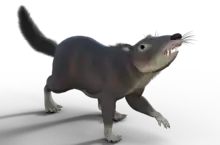Amphilestidae
Amphilestidae is a family of Mesozoic mammals, generally regarded as eutriconodonts. They may form a paraphyletic or polyphyletic assemblage, though they share with gobiconodontids their similar tooth occlusion patterns and may be especially closely related to them.[1] They occur from the Late Jurassic to Cenomanian,[2] and have a distribution across Laurasia
| Amphilestidae | |
|---|---|
| Scientific classification | |
| Kingdom: | Animalia |
| Phylum: | Chordata |
| Class: | Mammalia |
| Family: | †Amphilestidae Osborn, 1888 |
| Genera | |
| |
The putative amphilestid Tendagurodon is considered a non-amphilestid member of Amphilestheria along with the newly described Condorodon by Gaetano and Rougier (2012).[3]
References
- Percy M. Butler; Denise Sigogneau-Russell (2016). "Diversity of triconodonts in the Middle Jurassic of Great Britain" (PDF). Palaeontologia Polonica 67: 35–65. doi:10.4202/pp.2016.67_035.
- Jerry J. Hooker and Allan G. Lawson, 2011. A ‘eutriconodontan’ mammal from the UK Cenomanian (Late Cretaceous), Publication: Special Papers in Palaeontology 86: 255–261
- L. C. Gaetano and G. W. Rougier. 2012. First amphilestid from South America: a molariform from the Jurassic Cañadón Asfalto Formation, Patagonia, Argentina. Journal of Mammalian Evolution
This article is issued from Wikipedia. The text is licensed under Creative Commons - Attribution - Sharealike. Additional terms may apply for the media files.





